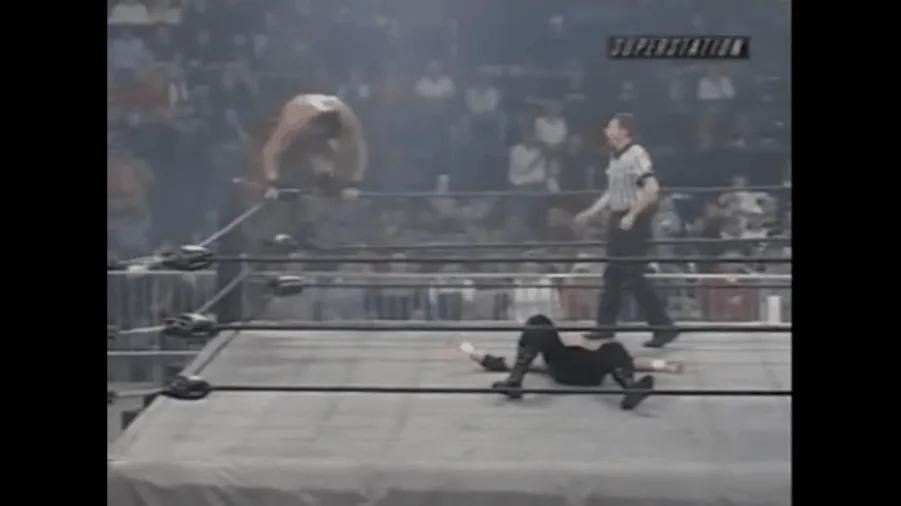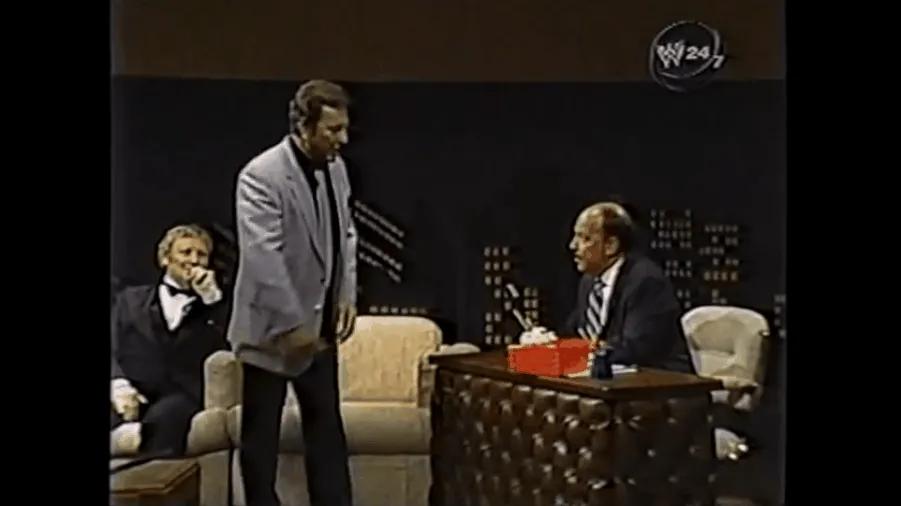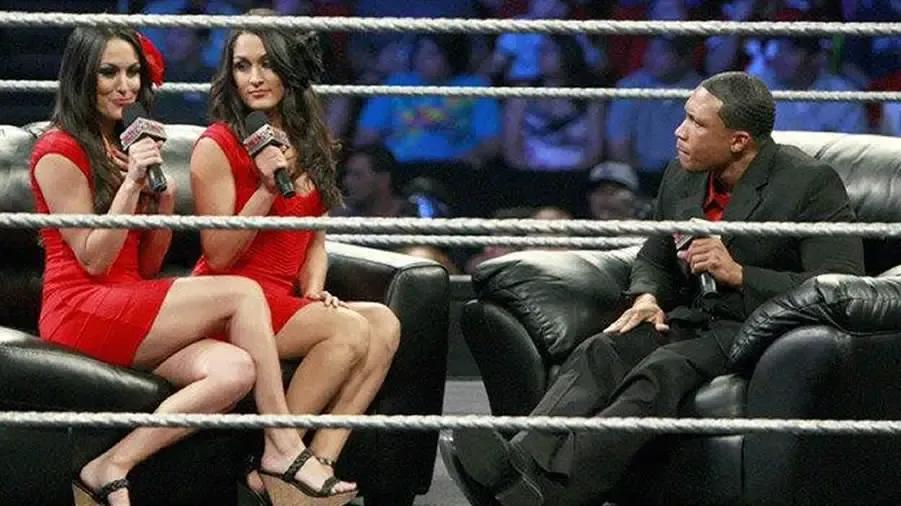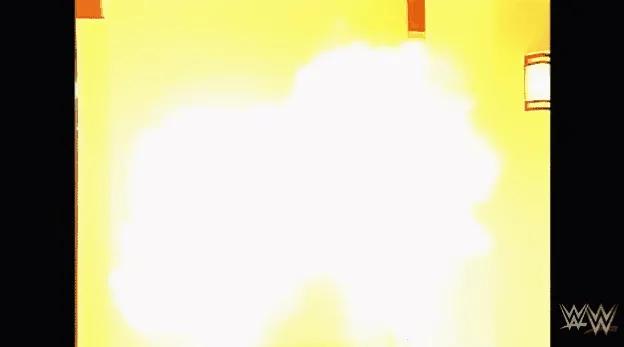10 Wrestling Debuts So Disastrous They Were Awesome
You only get one chance to make a first impression...

May 30, 2018
You only get one chance to make a first impression. For some, like Kane, The Undertaker, The Shield, AJ Styles (in WWE), and more, the first step onto the big stage was with the right foot forward. Others haven't been so lucky, as their moments of arrival have been prime cases of the phrase, "The less said, the better."
The following list will look at some of the most unfortunate wrestling debuts over the past few decades, instances in which the first impression was the worst impression. Some of the items herein were bad gimmicks made worse by a botch, a miscue, or some other blunder that has come to define said gimmick. Others were gimmicks with potential, but poor execution at the launching point would doom the performer. In the case of almost every entry on this list, the promoters and bookers just couldn't wash their hands of the act fast enough.
Chances are, you've probably already guessed what some of the top entries are, and you know their eff-up by heart. Others you may be less familiar with, but fear not: you'll learn of their calamities soon enough.

The year 2000 was not kind to WCW, which is like saying that a towering inferno isn't very friendly to a building's infrastructure. In February of that year (a brief lull between Vince Russo reigns of terror), WCW debuted a new wrestler on Thunder named The Machine. He was played by Emory Hale, a 6'9" powerhouse that looked like a cross between The Warlord and Horace Hogan, except that for this role, Hale would wear a black mask.
The impressive-looking Machine (after receiving a very elaborate entrance) debuted against Diamond Dallas Page on Thunder. The two would have a rather simple match, but with one unforgettable spot. As the beastly marauder climbed the turnbuckles, Page dove onto the ropes in order to crotch him. Instead of simply just crotching the buckle then and there, Machine stood straight up, fearfully screamed, then proceeded to broad-jump six or seven feet, crotching the top rope. Let's just say that after that bit of Botchamania gold, The Machine wasn't long for WCW television.

Throughout the 1980s, there were a few notable tag teams based on the face-painted, stud-and-steel-clad freaks from the Mad Max series of movies. The Road Warriors, Demolition, The Powers of Pain, and The Blade Runners (a young Ultimate Warrior and Sting) were all inspired by Mad Max's dystopian anarchy. When the Road Warriors split for WWE in the spring of 1990, that left WCW without any duos to fill that void. Enter The Master Blasters, Steel and Iron.
Steel was a very inexperienced, very green Kevin Nash with a mohawk, while Iron was a shorter bald man with a very muscular frame. As limited as Nash was at that point in his career, the man playing Iron was so much worse, missing falling headbutts, repeating moves from his limited arsenal and taking awkward bumps off of dropkicks and the like, all while unimpressed fans coolly booed. Their debut match at the September 1990 Clash of the Champions was apparently Iron's only match, as he was replaced shortly thereafter by a wrestler named Al Green, who took the name Rage.

In truth, veteran wrestler Christy had been kicking around WWE for a bit in the mid-80s as an enhancement talent, for the most part at events in Chicago (his home area) and Toronto-based TV tapings. For the most part, to WWE audiences, Christy came off very non-descript. In May of 1986, in a bit of a surprise, seldom-used Christy was granted an opportunity to be interviewed by Mean Gene Okerlund on Tuesday Night Titans, and he would actually get to demonstrate a gimmick. Sort of.
Christy emerged onto the interview set shooting fireballs out of some weird looking box. From there, he tried to establish that he was some sort of hypnotist that owned a bunch of apartment buildings and he had the ability to programme the minds of the audience, and yada yada. He attempted to perform some tricks, only to repeatedly lash out at Okerlund (out of character it seemed) for wrecking his concentration. After stumbling over his words several times, and boring the audience into a near-coma, the would-be magician mercifully made it to the end of this staggering train wreck. Little more than two months later, Christy quietly left the promotion.

The 30 June 2009 episode of ECW was infused with new talent. Sheamus wrestled his first televised match for the promotion, while Yoshi Tatsu scored an upset victory in his debut match, beating Shelton Benjamin. The dreadlocked Tyler Reks also appeared for the first time, challenging Zack Ryder to a match for Superstars. All three men came off far better in their first appearances than poor Abraham Washington.
Washington (later shortened to "AW" when he managed The Prime Time Players in 2012) debuted as the host of his own interview segment, The Abraham Washington Show. The skit proved to be an unmitigated disaster, as Washington struggled to deliver his pre-written lines (it did him no favours that "WWE humour" only comes off well if, say, The Rock delivers it), and generally just came off as unconvincing. He also interviewed The Bella Twins, straining the audience's patience as the three delivered weightless dialogue, and the Bellas teased dissension. It was so bad that WWE made "bad comedian" part of Washington's gimmick, as later incarnations of his segment would see the word "APPLAUSE" flash on the Titantron.

In the mid-nineties, martial arts-based fighting games like Mortal Kombat, Street Fighter, and Tekken were all the rage, while The Mighty Morphin Power Rangers remained a hot property for American youths. WWE wanted to tap into mediums that kids understood and enjoyed, so they came up with the Avatar gimmick, a mild-mannered individual that would apparently gain ultra-fighting powers upon donning a colourful mask. Al Snow, fresh from Smoky Mountain Wrestling, was given the role, and would debut with it in October 1995.
Snow's debut match in the get-up (which made him look like a hybrid of Hayabusa, Sabu, and Aldo Montoya) did not go well at all. Snow and enhancement worker Brian Walsh were not on the same page, and Snow himself messed up in a few spots (including a springboard to the outside). The clunky finish may as well have been a kiss of death for the Avatar gimmick, as Snow was pulled from the Underdogs team at the 1995 Survivor Series in favour of future rival Bob Holly. By the spring of 1996, Snow would be repackaged as New Rocker Leif Cassidy.

Wrestling fans may not believe it, but Adamle is actually a credible and beloved personality in the sports world. A former NFL running back of six years, Adamle crossed over into sports journalism as a studio host, sideline reporter, and even game show host (American Gladiators, anyone?). Adamle also did some sideline reporting for the XFL, which as we know would not be the last time he crossed paths with Vince McMahon.
With good delivery and a credible sports background, Adamle was hired by WWE in early-2008 to act as an interviewer and "field reporter". His first appearance at the 2008 Royal Rumble would see him make an unforgettable stumble, when, before the live New York crowd, he errantly referred to Jeff Hardy as "Jeff Harvey". The laughter and ridicule were immediate. After that, blunders became a part of the Adamle character, as WWE didn't even try to disguise the fact that Adamle was being used for yuks and laughs, up until his exit from the company that fall.

He's the one in the middle...
With WCW in absolute freefall by 1999, Eric Bischoff was scrambling for answers in order to try and stem the widening gap between his company and the wildly-popular WWE. On the heels of bringing in Master P and the No-Limit Soldiers to an unfavourable reaction, WCW struck a deal with another well-known musical act: KISS. The face-painted metal Gods performed a live concert on the 22 August 1999 edition of WCW Nitro, a segment that saw the ratings gradually peter out to near record lows (Raw won for the night 5.9 to 2.9).
From this concert emerged The Demon, a Gene Simmons-doppelganger portrayed by 6'6" former baseball player Dale Torborg. Torborg took the role after Brian "Crush" Adams managed to escape having to portray the character, but it didn't matter: fans had no interest in a KISS-themed wrestler, no matter who donned the make-up. The negative reaction to the concert passed onto the character, as WCW finally managed to rid themselves of the contractual obligation in early-2000.

The Dungeon of Doom wasn't exactly a career high-point for any of the players involved. The Shark was much cooler when he was The Earthquake, and nobody in their right mind would pick The Zodiac over Brutus "The Barber" Beefcake. The entire group was a collection of one misguided ghoul after another, all of whom (sans the well-protected Giant) would easily fall at the feet of Hulkamania.
The Giant wouldn't even be the largest member of the group. That distinction goes to the 7'3" Ron Reis, who would go on to play characters such as Big Ron Studd, as well as Reese of Raven's Flock. In the Dungeon, he was The Yeti (or, in Tony Schiavone's words, "THE YET-TAY!", a colossal mummy who emerged from a block of ice to aid in a Giant-led beatdown of Hogan at Halloween Havoc 1995. And how did The Yeti aid in the beatdown? Well, Giant had Hogan trapped in a bear hug, so Yeti added his own bear hug, which looked for all the world like Hogan was being dry-humped by Mecha Tutankhamen. The Yeti would then be repackaged as a giant masked ninja for reasons unclear (as unclear as why The Yeti was originally a friggin' mummy).

For weeks, *weeks*, WWE promoted this ginormous egg. Something was going to hatch from this massive egg at the 1990 Survivor Series, and nobody had a clue what it was going to be. Could it be Ted DiBiase's mystery partner? Could it be, as Mean Gene posited, "the Playmate of the month"? All of this hype for an egg, so it had better be something good.
And you know what it was, it was poor Hector Guerrero in a garish turkey costume. The crowd in Hartford, CT that fateful Thanksgiving night immediately rained down their displeasure as Guerrero and Mean Gene were left to try and carry on the bit (although Roddy Piper and Gorilla Monsoon may have had it worse on commentary, selling the ensuing dance routine with forced laughter). The idea was that the Gobbledy Gooker would have been a mascot that would pop up during shows to entertain children, not unlike The San Diego Chicken or The Phillie Phanatic. But after that catastrophic first run, and a handful of appearances after, the Gooker became a historic punchline, shelved forever save for a few tongue-in-cheek showings years later.

You saw this coming, right? Say what you will about the Gooker, but at least Guerrero's gymnastics and square dancing went off without him falling over his own two feet. The same can't be said for Fred Ottman, whose WCW debut was to have seen him burst onto the scene as a masked menace on the side of good, arriving to counter the ferocity of Sid Vicious, Vader, and any other evil-doer that tried to wreak havoc in WCW.
That was the idea, anyway. This so-called Shockmaster was set to make the big entrance on the set of A Flair For the Gold, at Sting's prompting. Seconds after Sting yelled his name, Ottman attempted to burst through a wall on the set like the world's scariest Kool-Aid Man, only to trip and fall flat on his face on live TV. To make matters worse, his face covering (a Stormtrooper's helmet covered in glitter) slid off of his head, and he had to hurriedly put it back on to protect his identity. The entire debut died a death, and the Shockmaster character had to be reconfigured, with Ottman now playing a clumsy construction worker that was well-meaning, but always fell down.